check engine light DODGE DURANGO 2008 2.G User Guide
[x] Cancel search | Manufacturer: DODGE, Model Year: 2008, Model line: DURANGO, Model: DODGE DURANGO 2008 2.GPages: 481, PDF Size: 7.75 MB
Page 358 of 481

If using a manual transmission vehicle for trailer towing,
all starts must be in FIRST gear to avoid excessive clutch
slippage.
Towing Tips Ð Automatic Transmission
The ªDº range can be selected when towing. However, if
frequent shifting occurs while in this range, the ªTOW
HAULº feature should be selected.
NOTE:Using the ªTOW HAULº feature while operat-
ing the vehicle under heavy operating conditions will
improve performance and extend transmission life by
reducing excessive shifting and heat build up. This action
will also provide better engine braking.
The automatic transmission fluid and filter should be
changed if you REGULARLY tow a trailer for more than
45 minutes of continuous operation. See the Maintenance
Schedule in section 8 of this manual for transmission
fluid change intervals.NOTE:Check the automatic transmission fluid level
before towing.
Towing Tips Ð Tow/Haul (If Equipped)
To reduce potential for automatic transmission overheat-
ing, turn the ªTOW HAULº feature ON when driving in
hilly areas or shift the transmission to Drive position 2 on
more severe grades.
Towing Tips Ð Electronic Speed Control (If
Equipped)
þ
Don't use in hilly terrain or with heavy loads.
þWhen using the speed control, if you experience speed
drops greater than 10 mph (16 km/h), disengage until
you can get back to cruising speed.
þUse speed control in flat terrain and with light loads to
maximize fuel efficiency.
358 STARTING AND OPERATING
Page 388 of 481

Loose Fuel Filler Cap Message
After fuel is added, the vehicle diagnostic system can
determine if the fuel filler cap is possibly loose, improp-
erly installed, or damaged. A loose fuel filler cap message
will be displayed in the instrument cluster. Tighten the
gas cap until a9clicking9sound is heard. This is an
indication that the gas cap is properly tightened. Press
the odometer reset button to turn the message off. If the
problem persists, the message will appear the next time
the vehicle is started. This might indicate a damaged cap.
If the problem is detected twice in a row, the system will
turn on the Malfunction Indicator Light (MIL). Resolving
the problem will turn the MIL light off.
EMISSIONS INSPECTION AND MAINTENANCE
PROGRAMS
In some localities, it may be a legal requirement to pass
an inspection of your vehicle's emissions control system.
Failure to pass could prevent vehicle registration.
For states which have an I/M (Inspection and
Maintenance) requirement, this check verifies the
following: the MIL (Malfunction Indicator Lamp)
is functioning and is not on when the engine is running,
and that the OBD (On Board Diagnostic) system is ready
for testing.
Normally, the OBD system will be ready. The OBD
system maynotbe ready if your vehicle was recently
serviced, if you recently had a dead battery, or a battery
replacement. If the OBD system is determined not ready
for the I/M test, your vehicle may fail the test.
388 MAINTAINING YOUR VEHICLE
Page 389 of 481
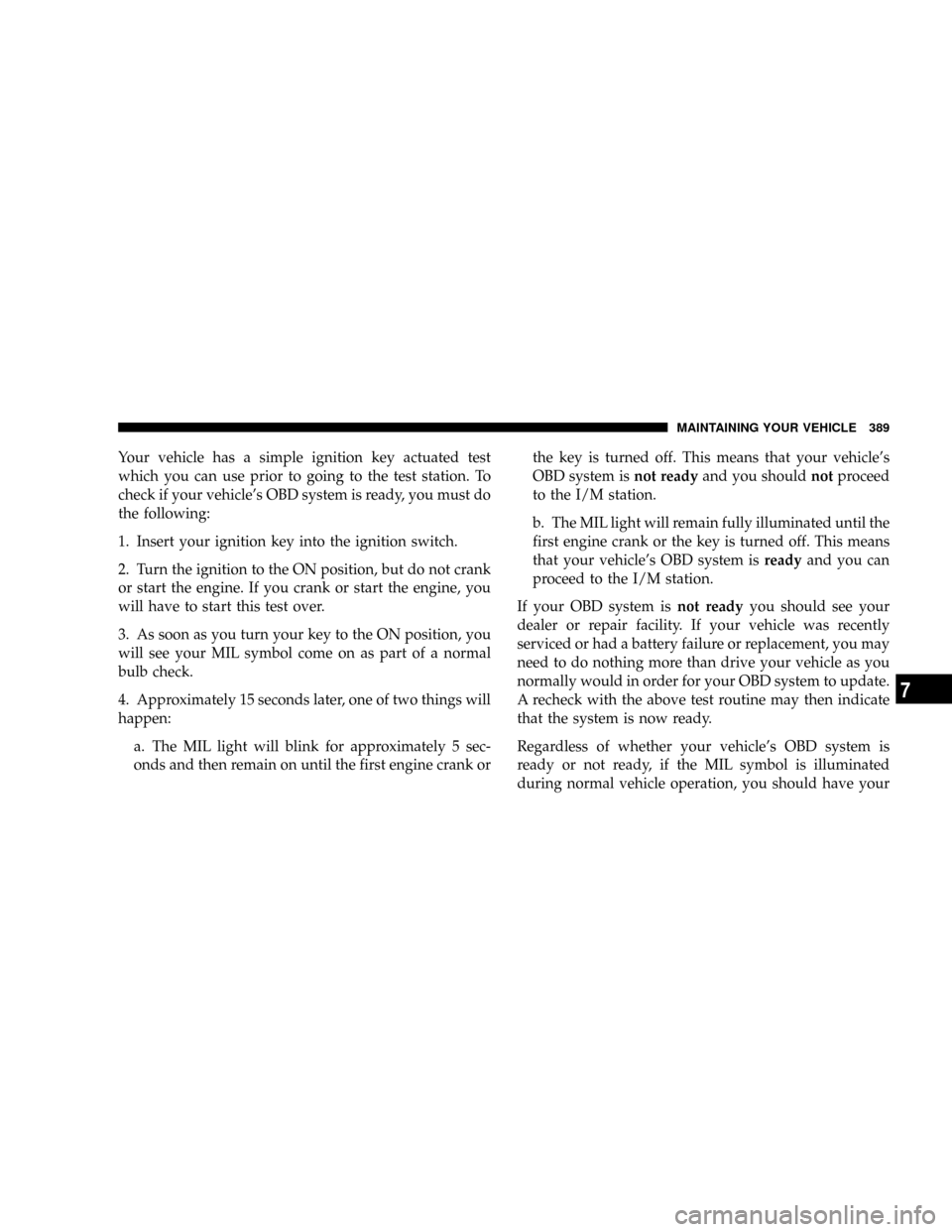
Your vehicle has a simple ignition key actuated test
which you can use prior to going to the test station. To
check if your vehicle's OBD system is ready, you must do
the following:
1. Insert your ignition key into the ignition switch.
2. Turn the ignition to the ON position, but do not crank
or start the engine. If you crank or start the engine, you
will have to start this test over.
3. As soon as you turn your key to the ON position, you
will see your MIL symbol come on as part of a normal
bulb check.
4. Approximately 15 seconds later, one of two things will
happen:
a. The MIL light will blink for approximately 5 sec-
onds and then remain on until the first engine crank orthe key is turned off. This means that your vehicle's
OBD system isnot readyand you shouldnotproceed
to the I/M station.
b. The MIL light will remain fully illuminated until the
first engine crank or the key is turned off. This means
that your vehicle's OBD system isreadyand you can
proceed to the I/M station.
If your OBD system isnot readyyou should see your
dealer or repair facility. If your vehicle was recently
serviced or had a battery failure or replacement, you may
need to do nothing more than drive your vehicle as you
normally would in order for your OBD system to update.
A recheck with the above test routine may then indicate
that the system is now ready.
Regardless of whether your vehicle's OBD system is
ready or not ready, if the MIL symbol is illuminated
during normal vehicle operation, you should have your
MAINTAINING YOUR VEHICLE 389
7
Page 402 of 481
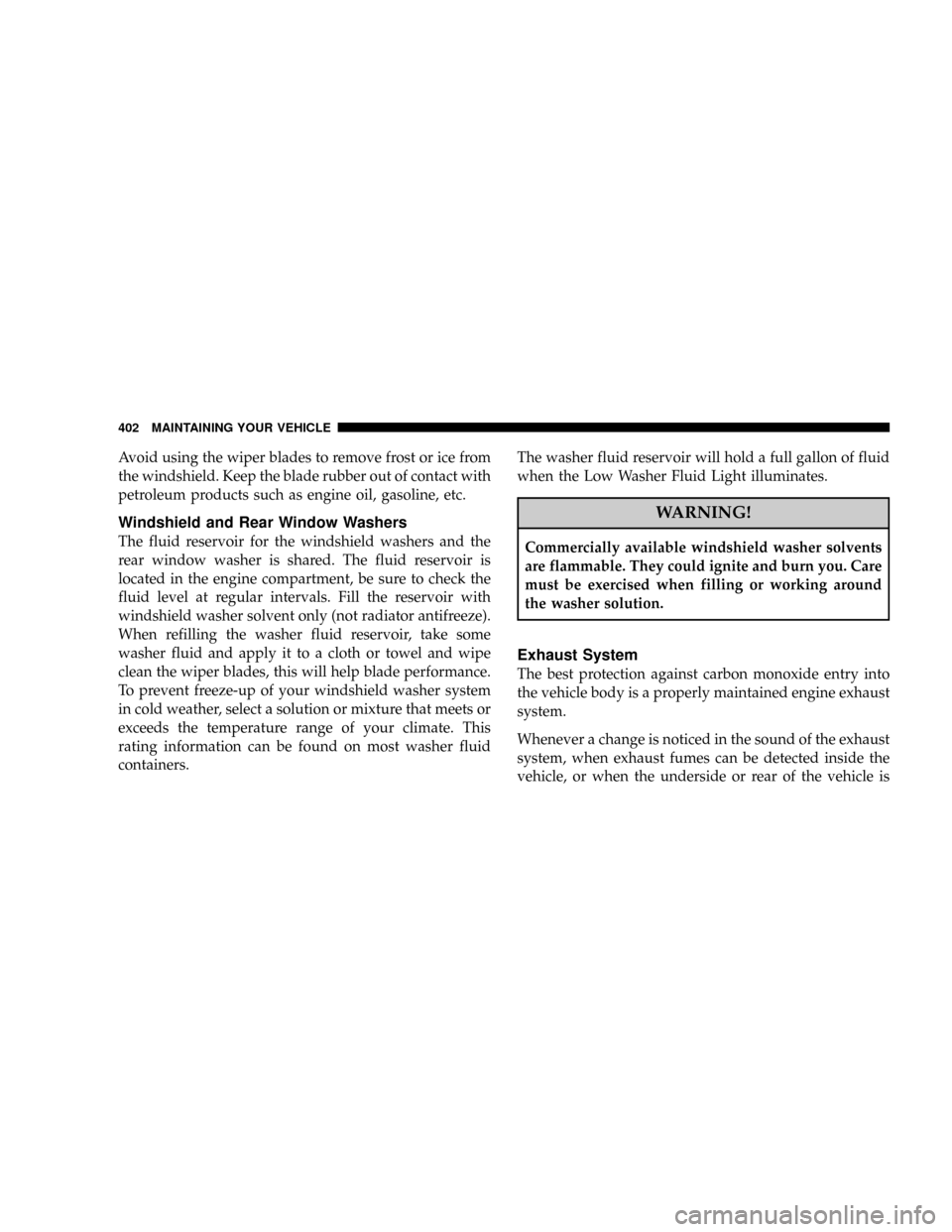
Avoid using the wiper blades to remove frost or ice from
the windshield. Keep the blade rubber out of contact with
petroleum products such as engine oil, gasoline, etc.
Windshield and Rear Window Washers
The fluid reservoir for the windshield washers and the
rear window washer is shared. The fluid reservoir is
located in the engine compartment, be sure to check the
fluid level at regular intervals. Fill the reservoir with
windshield washer solvent only (not radiator antifreeze).
When refilling the washer fluid reservoir, take some
washer fluid and apply it to a cloth or towel and wipe
clean the wiper blades, this will help blade performance.
To prevent freeze-up of your windshield washer system
in cold weather, select a solution or mixture that meets or
exceeds the temperature range of your climate. This
rating information can be found on most washer fluid
containers.The washer fluid reservoir will hold a full gallon of fluid
when the Low Washer Fluid Light illuminates.
WARNING!
Commercially available windshield washer solvents
are flammable. They could ignite and burn you. Care
must be exercised when filling or working around
the washer solution.
Exhaust System
The best protection against carbon monoxide entry into
the vehicle body is a properly maintained engine exhaust
system.
Whenever a change is noticed in the sound of the exhaust
system, when exhaust fumes can be detected inside the
vehicle, or when the underside or rear of the vehicle is
402 MAINTAINING YOUR VEHICLE
Page 410 of 481
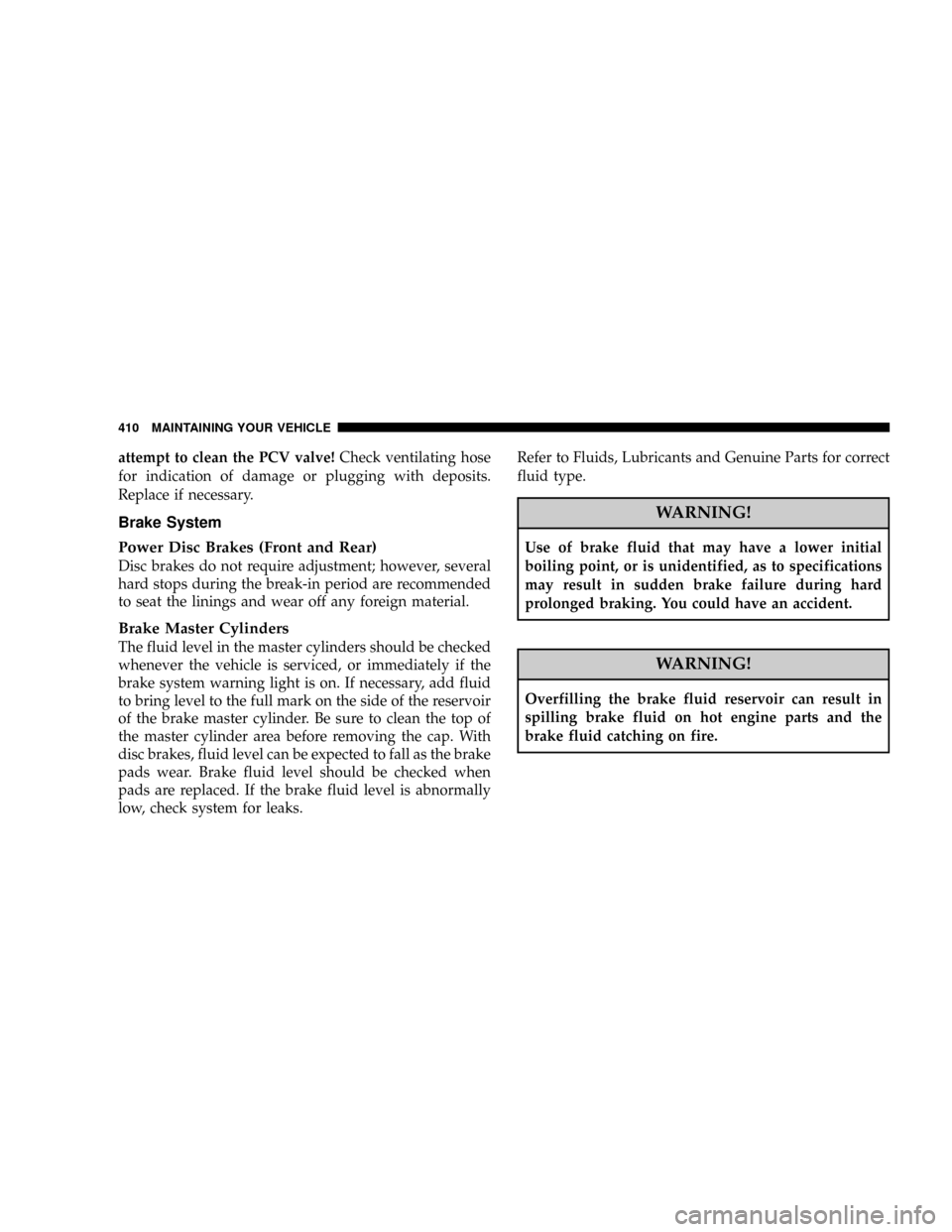
attempt to clean the PCV valve!Check ventilating hose
for indication of damage or plugging with deposits.
Replace if necessary.
Brake System
Power Disc Brakes (Front and Rear)
Disc brakes do not require adjustment; however, several
hard stops during the break-in period are recommended
to seat the linings and wear off any foreign material.
Brake Master Cylinders
The fluid level in the master cylinders should be checked
whenever the vehicle is serviced, or immediately if the
brake system warning light is on. If necessary, add fluid
to bring level to the full mark on the side of the reservoir
of the brake master cylinder. Be sure to clean the top of
the master cylinder area before removing the cap. With
disc brakes, fluid level can be expected to fall as the brake
pads wear. Brake fluid level should be checked when
pads are replaced. If the brake fluid level is abnormally
low, check system for leaks.Refer to Fluids, Lubricants and Genuine Parts for correct
fluid type.
WARNING!
Use of brake fluid that may have a lower initial
boiling point, or is unidentified, as to specifications
may result in sudden brake failure during hard
prolonged braking. You could have an accident.
WARNING!
Overfilling the brake fluid reservoir can result in
spilling brake fluid on hot engine parts and the
brake fluid catching on fire.
410 MAINTAINING YOUR VEHICLE
Page 413 of 481
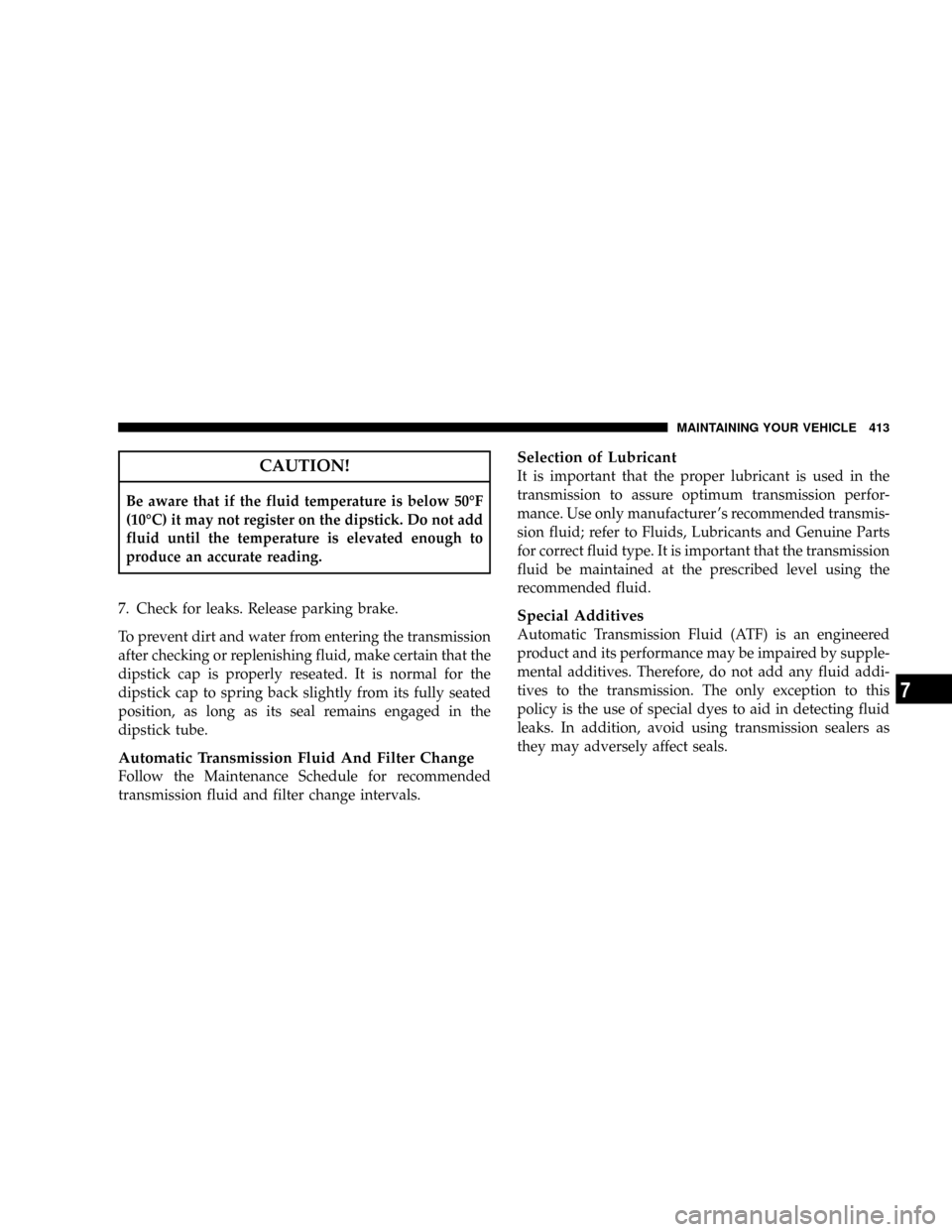
CAUTION!
Be aware that if the fluid temperature is below 50ÉF
(10ÉC) it may not register on the dipstick. Do not add
fluid until the temperature is elevated enough to
produce an accurate reading.
7. Check for leaks. Release parking brake.
To prevent dirt and water from entering the transmission
after checking or replenishing fluid, make certain that the
dipstick cap is properly reseated. It is normal for the
dipstick cap to spring back slightly from its fully seated
position, as long as its seal remains engaged in the
dipstick tube.
Automatic Transmission Fluid And Filter Change
Follow the Maintenance Schedule for recommended
transmission fluid and filter change intervals.
Selection of Lubricant
It is important that the proper lubricant is used in the
transmission to assure optimum transmission perfor-
mance. Use only manufacturer 's recommended transmis-
sion fluid; refer to Fluids, Lubricants and Genuine Parts
for correct fluid type. It is important that the transmission
fluid be maintained at the prescribed level using the
recommended fluid.
Special Additives
Automatic Transmission Fluid (ATF) is an engineered
product and its performance may be impaired by supple-
mental additives. Therefore, do not add any fluid addi-
tives to the transmission. The only exception to this
policy is the use of special dyes to aid in detecting fluid
leaks. In addition, avoid using transmission sealers as
they may adversely affect seals.
MAINTAINING YOUR VEHICLE 413
7
Page 446 of 481
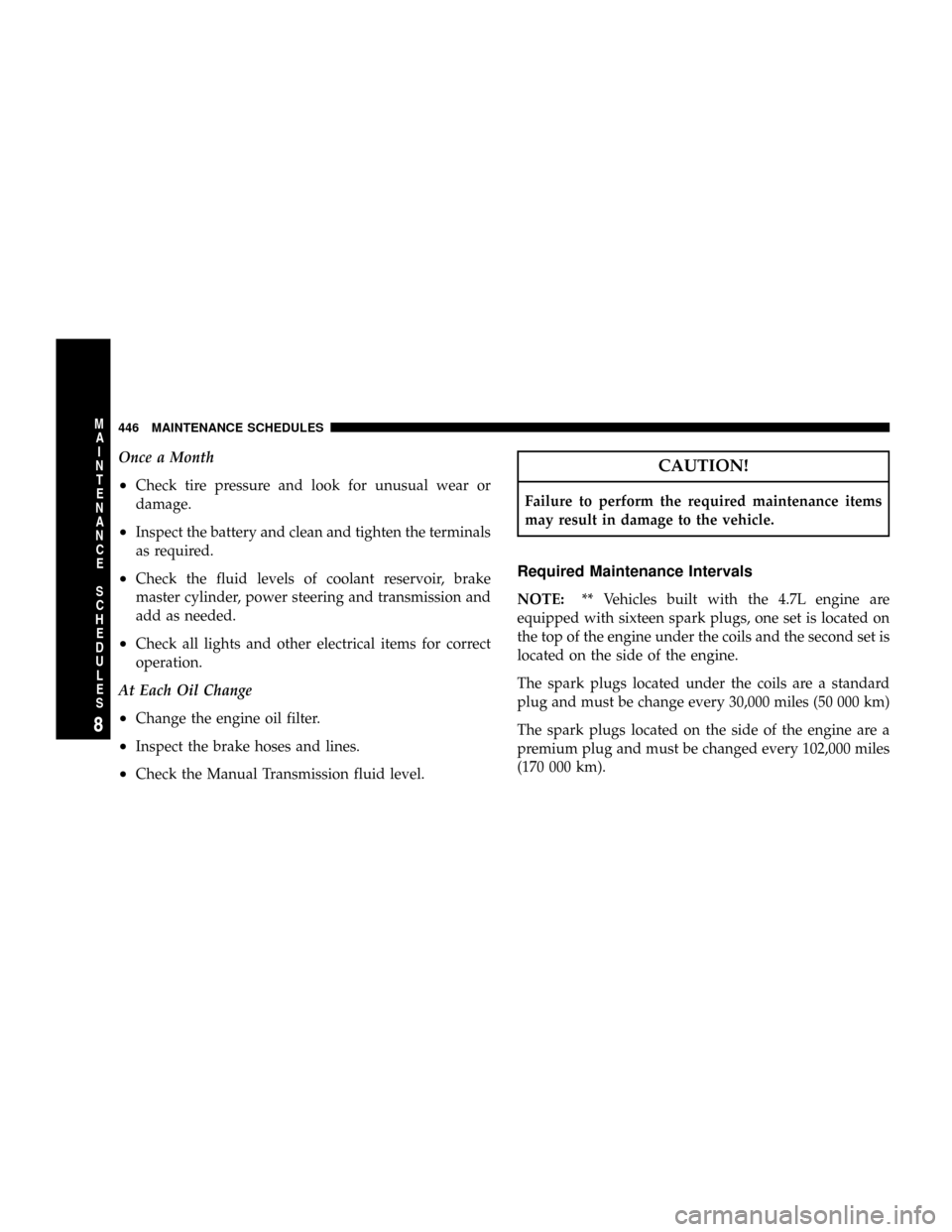
Once a Month
²Check tire pressure and look for unusual wear or
damage.
²Inspect the battery and clean and tighten the terminals
as required.
²Check the fluid levels of coolant reservoir, brake
master cylinder, power steering and transmission and
add as needed.
²Check all lights and other electrical items for correct
operation.
At Each Oil Change
²Change the engine oil filter.
²Inspect the brake hoses and lines.
²Check the Manual Transmission fluid level.
CAUTION!
Failure to perform the required maintenance items
may result in damage to the vehicle.
Required Maintenance Intervals
NOTE:** Vehicles built with the 4.7L engine are
equipped with sixteen spark plugs, one set is located on
the top of the engine under the coils and the second set is
located on the side of the engine.
The spark plugs located under the coils are a standard
plug and must be change every 30,000 miles (50 000 km)
The spark plugs located on the side of the engine are a
premium plug and must be changed every 102,000 miles
(170 000 km).
446 MAINTENANCE SCHEDULES
8
M
A
I
N
T
E
N
A
N
C
E
S
C
H
E
D
U
L
E
S
Page 462 of 481
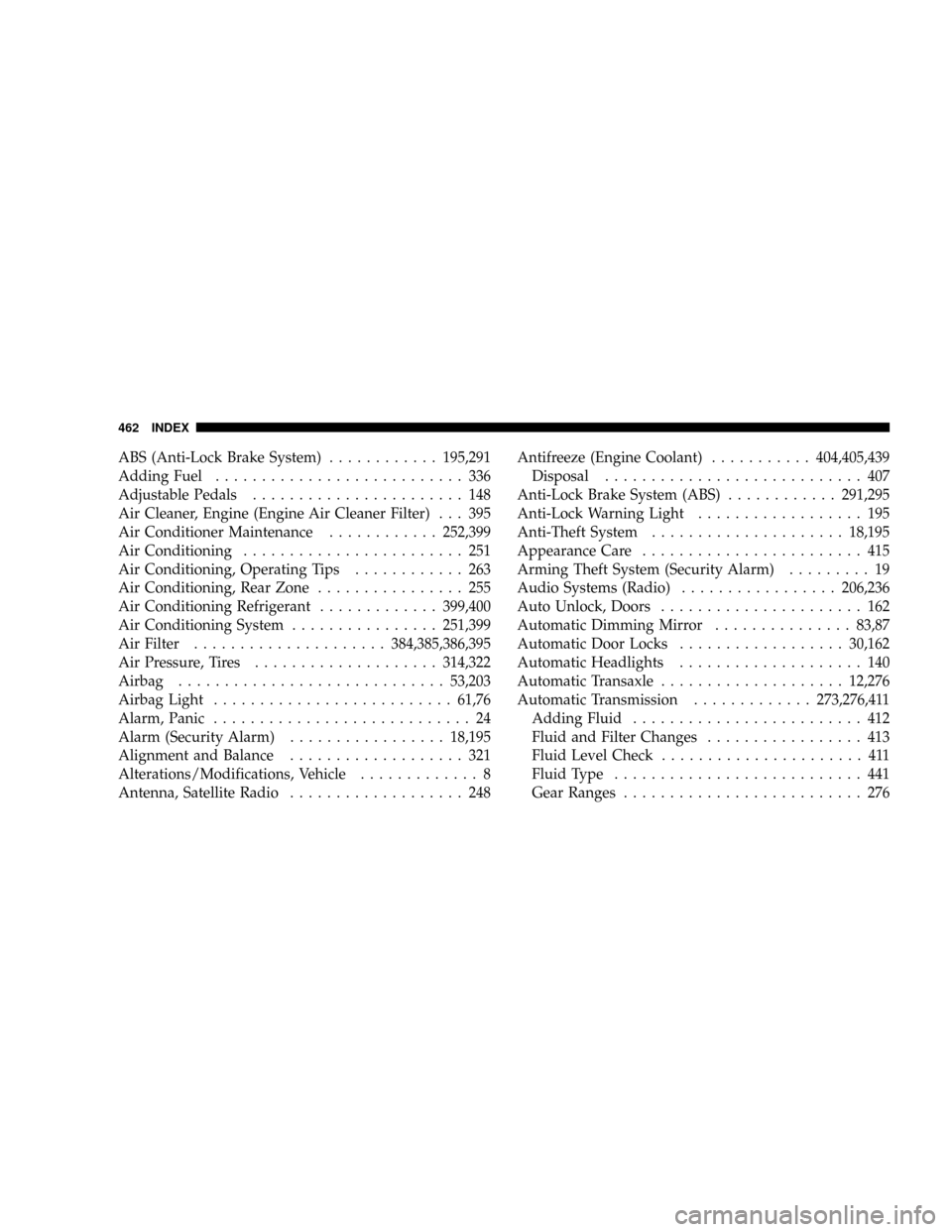
ABS (Anti-Lock Brake System)............195,291
Adding Fuel........................... 336
Adjustable Pedals....................... 148
Air Cleaner, Engine (Engine Air Cleaner Filter) . . . 395
Air Conditioner Maintenance............252,399
Air Conditioning........................ 251
Air Conditioning, Operating Tips............ 263
Air Conditioning, Rear Zone................ 255
Air Conditioning Refrigerant.............399,400
Air Conditioning System................251,399
Air Filter.....................384,385,386,395
Air Pressure, Tires....................314,322
Airbag.............................53,203
Airbag Light..........................61,76
Alarm, Panic............................ 24
Alarm (Security Alarm).................18,195
Alignment and Balance................... 321
Alterations/Modifications, Vehicle............. 8
Antenna, Satellite Radio................... 248Antifreeze (Engine Coolant)...........404,405,439
Disposal............................ 407
Anti-Lock Brake System (ABS)............291,295
Anti-Lock Warning Light.................. 195
Anti-Theft System.....................18,195
Appearance Care........................ 415
Arming Theft System (Security Alarm)......... 19
Audio Systems (Radio).................206,236
Auto Unlock, Doors...................... 162
Automatic Dimming Mirror...............83,87
Automatic Door Locks..................30,162
Automatic Headlights.................... 140
Automatic Transaxle....................12,276
Automatic Transmission.............273,276,411
Adding Fluid......................... 412
Fluid and Filter Changes................. 413
Fluid Level Check...................... 411
Fluid Type........................... 441
Gear Ranges.......................... 276
462 INDEX
Page 467 of 481
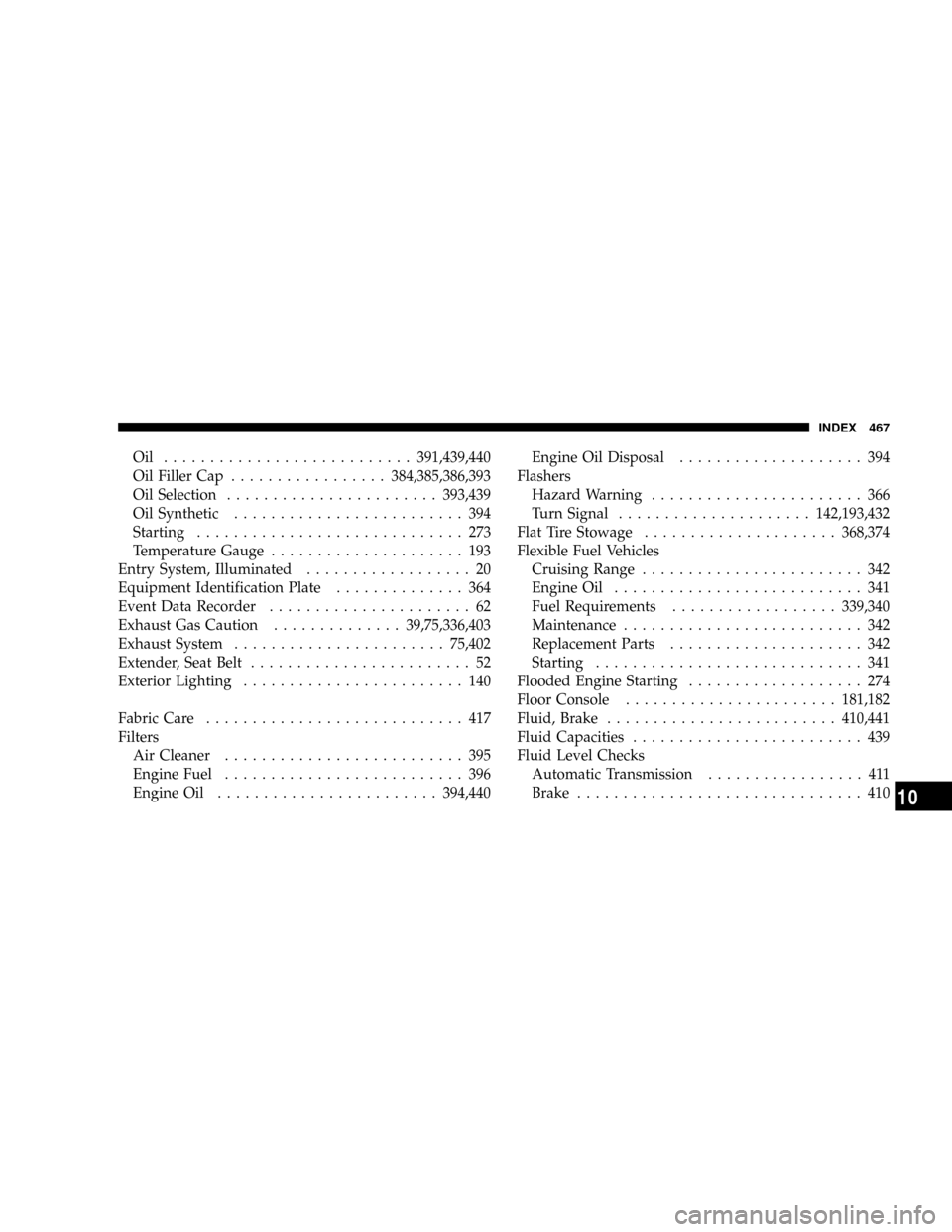
Oil ...........................391,439,440
Oil Filler Cap.................384,385,386,393
Oil Selection.......................393,439
Oil Synthetic......................... 394
Starting............................. 273
Temperature Gauge..................... 193
Entry System, Illuminated.................. 20
Equipment Identification Plate.............. 364
Event Data Recorder...................... 62
Exhaust Gas Caution..............39,75,336,403
Exhaust System.......................75,402
Extender, Seat Belt........................ 52
Exterior Lighting........................ 140
Fabric Care............................ 417
Filters
Air Cleaner.......................... 395
Engine Fuel.......................... 396
Engine Oil........................394,440Engine Oil Disposal.................... 394
Flashers
Hazard Warning....................... 366
Turn Signal.....................142,193,432
Flat Tire Stowage.....................368,374
Flexible Fuel Vehicles
Cruising Range........................ 342
Engine Oil........................... 341
Fuel Requirements..................339,340
Maintenance.......................... 342
Replacement Parts..................... 342
Starting............................. 341
Flooded Engine Starting................... 274
Floor Console.......................181,182
Fluid, Brake.........................410,441
Fluid Capacities......................... 439
Fluid Level Checks
Automatic Transmission................. 411
Brake............................... 410
INDEX 467
10
Page 471 of 481
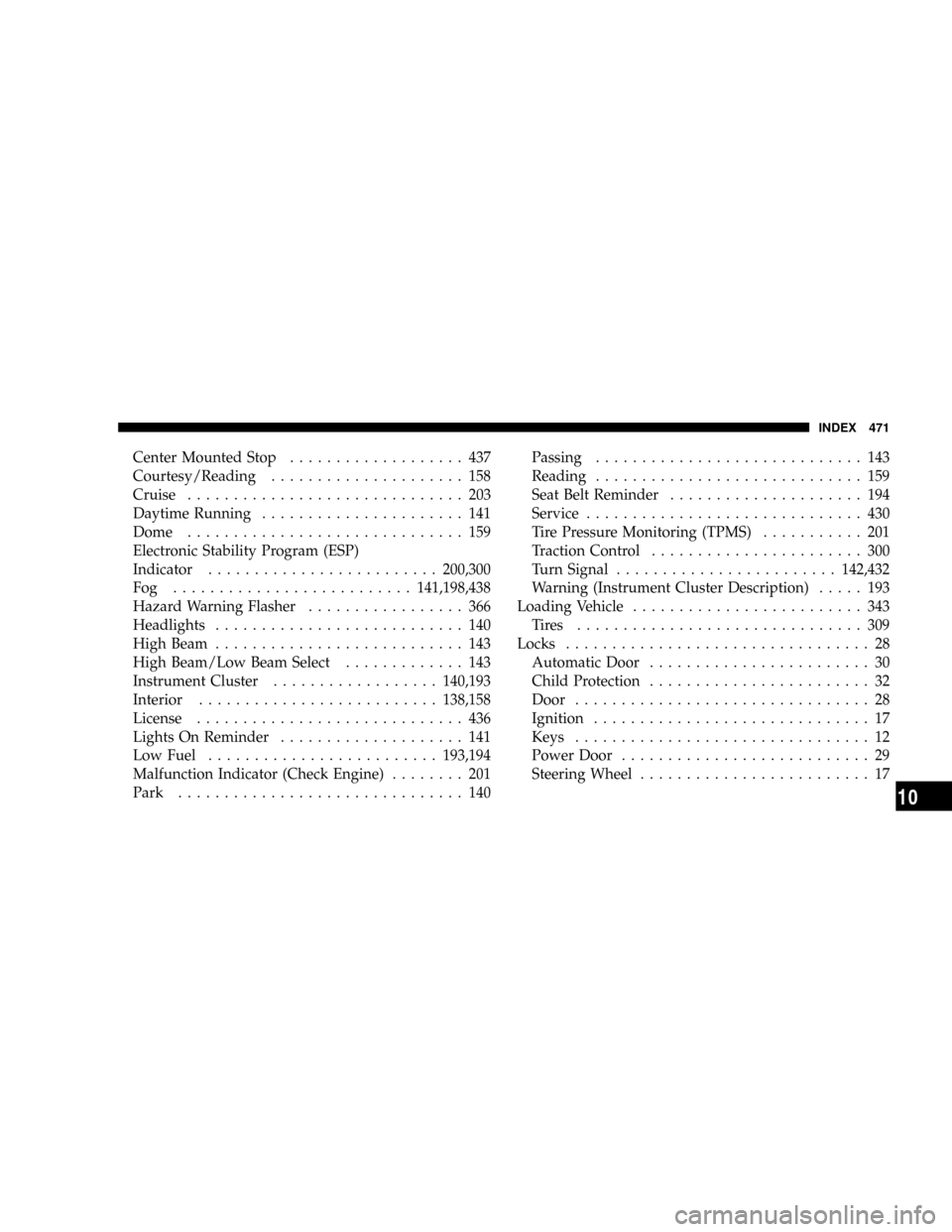
Center Mounted Stop................... 437
Courtesy/Reading..................... 158
Cruise.............................. 203
Daytime Running...................... 141
Dome.............................. 159
Electronic Stability Program (ESP)
Indicator.........................200,300
Fog ..........................141,198,438
Hazard Warning Flasher................. 366
Headlights........................... 140
High Beam........................... 143
High Beam/Low Beam Select............. 143
Instrument Cluster..................140,193
Interior..........................138,158
License............................. 436
Lights On Reminder.................... 141
Low Fuel.........................193,194
Malfunction Indicator (Check Engine)........ 201
Park............................... 140Passing............................. 143
Reading............................. 159
Seat Belt Reminder..................... 194
Service.............................. 430
Tire Pressure Monitoring (TPMS)........... 201
Traction Control....................... 300
Turn Signal........................142,432
Warning (Instrument Cluster Description)..... 193
Loading Vehicle......................... 343
Tires ............................... 309
Locks................................. 28
Automatic Door........................ 30
Child Protection........................ 32
Door................................ 28
Ignition.............................. 17
Keys................................ 12
Power Door........................... 29
Steering Wheel......................... 17
INDEX 471
10